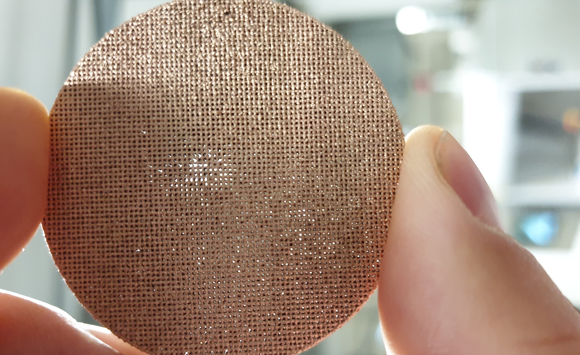University of Wolverhampton researchers additively manufacture COVID-19 resistant metal
February 17, 2021

The University of Wolverhampton’s Additive Manufacturing Functional Materials (AMFM) research group, Wolverhampton, UK, has developed an antiviral material made from copper, silver and tungsten which can be additively manufactured and reportedly kills the coronavirus (COVID-19).
AMFM explains that the COVID-19 pandemic has highlighted the need for materials and surfaces that can kill or suppress the virus to help reduce airborne and surface-based transmission. With expertise in additively manufacturing antimicrobial biomaterials, the research group refocused their efforts to investigate antiviral materials that could combat COVID-19.
The interdisciplinary project was led by the University of Wolverhampton’s John Robinson, Dr Arun Arjunan and Dr Ahmad Baroutaji, who partnered with the Ángel Serrano-Aroca’s group from the Catholic University of Valencia’s Biomaterials and Bioengineering Lab for rapid material development and anti-COVID-19 viral analysis.
PhD researcher John Robinson, stated, “COVID-19 virus transmission can be indirect through airborne droplets or direct through contaminated surfaces. Therefore, the ability to control the transmission of the virus is critical to reduce the spread and limit the unknown long-term effects.”
“Also, with new variants emerging, and a concern that a vaccine evasive strain may evolve, there is further emphasis on the requirement for enhanced transmission control and prevention. The requirement for long life masks and mask filters that can be disinfected is essential.”
“As the pandemic continues to evolve, various situations are likely to appear unpredictably,” Robinson continued. “To enable an immediate response and rapid solution, we created an antiviral material that could be 3D printed and therefore can create antiviral surfaces when and where they are needed.”
The researchers used Laser Beam Powder Bed Fusion (PBF-LB) technology to additively manufacture a novel antiviral copper-tungsten-silver material.
Silver is known to have antimicrobial properties – the relatively high-cost, however, brings challenges for large-scale implementation, particularly in regard to single-use products. Similarly, copper has been highlighted as having anti-COVID-19 properties with the advantage of having a relatively lower cost compared to silver. Recent studies have reported COVID-19 viral inactivation of 99.2% in five hours using copper-coated surfaces.
Although limited, there is also emerging research that tungsten also has antimicrobial effects against common pathogens such as E. coli and Staphylococcus aureus, explains the research group.
The project investigated combining these three elements to fabricate a novel antiviral material that can be additively manufactured to create touch surfaces and filter geometries while having superior anti-COVID-19 viral properties.
“Our antiviral material displayed a 100% viral inactivation within five hours against a biologically-safe sample of COVID-19,” added Robinson. “This is a significant improvement on the previous copper coating results as all of the COVID-19 virus is eliminated. As such, the copper-tungsten-silver material developed in this study could be utilised to reduce both surface contamination and the airborne spread of the COVID-19 virus.”
“We hope that this material could have a number of uses including building filtration systems and face mask filters. For example, in this project, we used the antiviral material and 3D printing technology to create proof of concept mask filters for an open-source 3D printed face mask,” Robinson concluded.
















